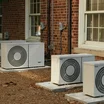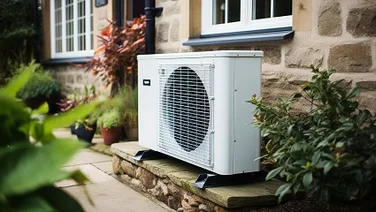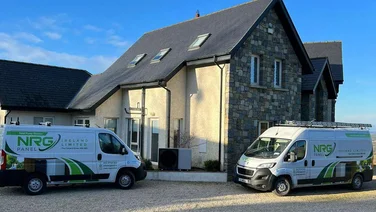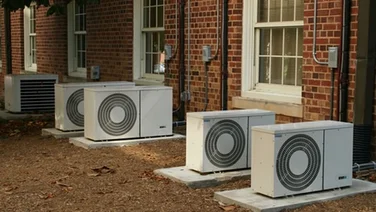- What is an air source heat pump?
- How is an air source heat pump installed?
- How much does an air source heat pump installation cost?
- Heat pump running costs
- Is there any maintenance required afterwards?
- How many heat pump installers are there in the UK?
- Will heat pumps save me money?
- Next steps
- Summary
- Installing an air source heat pump usually takes around three days
- They can cut your carbon footprint by a substantial amount
- The installation process requires electrical and plumbing expertise

Air source heat pumps are a great way to reduce your impact on the planet while also benefiting from a huge “bang for your buck” in heating (and cooling) your home. These systems are not the cheapest to install and won’t save your megabucks from the off, but this will change considerably should electricity become cheaper than gas in the future.
That being said, getting an air source heat pump costs less than a gas boiler over its lifetime. And considering the Boiler Upgrade Scheme can now cut £7,500 off air source heat pump costs for homeowners, this is the time to act. This scheme has proved so popular, in fact, that the government has already committed extra funding.
Here’s everything you need to know about how installers will set you up with a new, top-quality air source heat pump.
If you want to see how much a heat pump would cost you, just answer a few quick questions in our custom-built comparison tool, and our specialist suppliers will be in touch with free quotes for you to compare.
What type of central heating do you currently use?
Get started
What is an air source heat pump?
An air source heat pump is a renewable heating system that uses electricity to take warmth from the air outside and uses it to supply you with heat and, in some cases, hot water.
The heat pump machine’s refrigerant absorbs warmth from outside and becomes a gas as it heats up beyond -50°C.
The gas is compressed, which results in it warming up due to the pressure increase. It then transfers this heat to your central heating system’s water.
For systems that are able to, when you’re not using your heating system, you can store the excess fluid in a hot water cylinder.
And because the sun has already partly heated the air, an air source heat pump is able to produce more units of heat than the units of electricity it uses, making it an extremely efficient source of green energy.

Want to get a better idea of what it’s like to own an air source heat pump? Check out our case study with Louise, from South London.
Louise had a 12-kilowatt air source heat pump installed to reduce her reliance on fossil fuels, and received £5,000 off the upfront cost through the Boiler Upgrade Scheme. Now, Louise can enjoy a warm, even temperature throughout the house, without fluctuations.
Take a look at the full interview with Louise to learn more.

Get £7500 towards your heat pump installation through a trusted installer
An MCS-certified heat pump installer can apply for the Boiler Upgrade Scheme on your behalf, get a quote from one now
How is an air source heat pump installed?
The air source heat pump installation process is painless, provided you hire a professional company with installers who are qualified and certified.
To ensure you make the right choice for your home, read our guide to the best heat pump installers in the UK.
Don’t install an air source heat pump yourself, unless you’re certified in electrical and plumbing work. Any savings you make initially will be eradicated when the system breaks.
We’ve laid out all the steps below that will take you towards the destination of a new, functioning air source heat pump, so you know what your installers are doing.
1. Inspection
The best first step is to ask a company that installs heat pumps to send a heating engineer to assess your home and decide what size of air source heat pump you need.
Some companies will perform this survey for free, while others charge £500 in the form of a non-refundable deposit.
This payment is often removed if you choose the assessing company to carry out the heat pump installation, but either way, it’s incredibly useful to know how to save money on your energy bills.
The engineer will measure how big your home is, the number of rooms you need to heat, your insulation levels, and the size of your radiators.
This process can take up to four hours.
They’ll also take into account if you have underfloor heating, which is an excellent way to spread warmth through your home when you have a heat pump.
All of these considerations will help them work out how much heat is regularly lost from your home. The more heat that’s lost, the bigger the heat pump you’ll need.
To reduce heat losses and make your home more suitable for a heat pump, the engineer may recommend getting better insulation, bigger radiators, or underfloor heating. They may be able to carry out these improvements for you while installing the heat pump.
Fortunately, many radiators in UK homes are already larger than they need to be for gas heating, which may be perfect for your new heat pump. Generally, most homes will need to replace around one-third of their radiators before installing a heat pump.
2. The outdoor unit
The actual heat pump will then be installed just outside your home, next to one of the external walls.
The heat pump needs easy access to the air, so your installer will choose a spot where nothing blocks it in, then either bolt it to a flat concrete base, or use brackets to attach it to the wall.
This ensures that come rain, hail, or snow, your heat pump will remain steadfast in its position.

Get free heat pump quotes
Answer a few quick questions, and our trusted installers will send you bespoke heat pump quotes – for free.
3. The indoor unit
Once the outdoor heat pump is installed, your installer will move inside to complete the system setup,
In many UK homes, air-source heat pumps are designed not just to heat your home but also to supply domestic hot water. To do this efficiently, they often work in tandem with a hot water cylinder, which stores heated water for use later.
If your system is configured this way, the installer will set up a compatible cylinder (usually in an airing cupboard or utility room) to hold hot water generated by the heat pump when it’s not needed immediately for space heating.
Your installer will help you choose the right size for your home, but as a rough guide:
- A two-bedroom home might need a 150-litre cylinder
- A typical three-bedroom home often requires around 200 litres
- Larger homes may need 300 litres or more
If you already have a hot water cylinder from a previous system, it may need to be replaced, as standard models often have coils that are too small to reheat water quickly enough with a heat pump.
4. Connections
Next, your installer will connect the components of the system — linking the outdoor heat pump with your home’s heating and, if applicable, hot water setup.
This usually involves running a control wire, a refrigerant hose, and a condensate drain hose from the external unit to the internal one. To do this, they’ll typically drill a small hole through an external wall.
If your system includes a hot water cylinder, it will also be connected at this stage. The installer will run pipework from the cylinder to your radiators and underfloor heating if you have it, so the system can distribute warmth effectively throughout your home.
If your heat pump also provides hot water, these connections will ensure the cylinder stores heated water for taps, showers, and other household uses.
During this process, your old heating system (like a gas boiler) will need to be disconnected. This is usually a quick job, but your installer will let you know in advance when and how long it will take.
This part of the installation involves both plumbing and electrical work, so having a qualified professional is essential to make sure everything works safely and efficiently.
What type of central heating do you currently use?
Get started
How much does an air source heat pump installation cost?
Installing an air source heat pump costs between £3,000 and £15,000 (depending on the system in question).
Ensure you get multiple quotes before moving ahead with an installer to avoid paying well over the odds.
And remember: unless you’re a certified plumber and electrician, don’t do it yourself. The price of installing a heat pump to an inferior standard will likely be much higher in the long term.
Heat pump running costs
The average air source heat pump will cost you between £800 and £1,600 annually. This is a wide range, as costs will vary significantly depending on things like the size of your home (and installed system), where you live in the UK, and how you use the system.
Costs can be saved using specially designed tariffs, like Octopus Energy’s “Cosy Octopus” which would, on average, save you around £213 a year compared to a gas boiler.
| Heating method | Efficiency (%) | Annual energy use (kWh) | Cost (p/kWh) | Annual bill |
|---|---|---|---|---|
| Gas boiler | 95 | 11,500 | 6.04 | £694 |
| Heat pump | 300 | 3,833 | 24.50 | £939 |
| Oil boiler | 92 | 11,875 | 11.14 | £1,337 |
| Electric boiler | 100 | 10,925 | 24.50 | £2,676 |
Is there any maintenance required afterwards?
Yes – but thankfully, air source heat pump maintenance is a relatively simple task.
You can do your part by keeping the external unit clean and free of debris so the airflow doesn’t get obstructed and by cleaning the registers with a soft-bristled brush.
Don’t let grass or other plants encroach on the heat pump’s area, and de-ice your machine in winter.
But you should also hire a professional once per year, so they can replace the filters, wipe down the coils and fan blades, and refill the antifreeze.
With very little upkeep, an air source heat pump can last for at least 20 years – much longer than a gas boiler, which typically needs replacing after 10 to 15 years.

Get free heat pump quotes
Answer a few quick questions, and our trusted installers will send you bespoke heat pump quotes – for free.
How many heat pump installers are there in the UK?
There are currently 250,000 Microgeneration Certification Scheme-certified heat pump installers in the UK.
This falls well short of the number needed if the government is to meet its target of 600,000 heat pumps installed annually by 2028. This is especially the case when compared with the UK’s 130,000 certified gas boiler installers (as of 2019).
With its 2028 goal in mind, the government now offers free or subsidised training to tradespeople who want to learn how to install heat pumps under the BEIS Skills Training Competition scheme.
With 18 training providers across the country offering this course, we should see a massive increase in the number of heat pump installers over the next few years.
The government has also launched the £5 million Heat Training Grant, which will provide up to 10,000 engineers with a £500 discount to take a heat pump training course.
As it stands, only 51% of UK residents are aware of heat pumps, according to our National Home Energy Survey, which also needs to change if we’re going to reach net zero.
Will heat pumps save me money?
When comparing air-source heat pumps to more conventional heating, like gas boilers, one crucial concept to understand is the ‘Spark Gap’. This is the difference in the cost per unit between gas and electricity, and it plays a massive role in how much you’ll pay to run your heating system.
Currently, electricity costs significantly more per unit than gas in the UK. That’s despite heat pumps being far more efficient, producing three to four units of heat for every unit of electricity used. This difference is called the ‘Spark Gap’.
It’s also why your electricity bill may feel higher with an air source heat pump. On average, households see an increase of around £939 in electricity costs after switching. However, this doesn’t necessarily mean you’ll be paying more overall.
For example, you won’t need to pay for gas anymore, and in a well-insulated home with the right setup, a heat pump can still be cheaper to run over the long term.
There are signs the ‘Spark Gap’ may narrow in the future, especially as the UK continues to shift taxes and levies off electricity and onto fossil fuels to promote greener energy. In the meantime, using a heat pump tariff can help reduce your running costs.
The air source heat pump installation process is painless, provided you hire a professional company with installers who are qualified and certified. To ensure you make the right choice for your home, read our guide to the best heat pump installers in the UK.
It is important to note that unless you’re a certified heat pump engineer, you shouldn’t install your own air-source heat pump. The process involves complex electrical and plumbing work, so any money saved upfront could be lost in repair costs.
Worse, you could end up without heating if something goes wrong.
You also don’t usually need planning permission to install an air source heat pump unless your home is listed or you already have one installed. Your installer must still follow key regulations. For example, the heat pump must be used solely for heating purposes, installed at least a metre away from your property’s boundary, and carried out by a certified professional under the Microgeneration Certification Scheme (MCS).
Next steps
You’re now fully prepared to save money and energy with your new heat pump.
The next step is to ask for a heat loss assessment of your property, make any necessary improvements, and then buy the best heat pump for you.
With the government’s Boiler Upgrade Scheme, you could save £7,500 on a new heat pump – and reduce your annual emissions by 44%.If that sounds good to you, you can find out how much a heat pump would set you back by filling in this short form. Our excellent suppliers will provide you with free quotes.
Summary
- An air source heat pump isn’t just a greener choice, it’s an investment in long-term comfort and efficiency.
- With the right setup and support, switching to a heat pump can lower emissions and future-proof your home.
- Installing a heat pump might seem like a big step, but the savings and sustainability benefits make it worthwhile.
- Now’s the time to take advantage of government incentives and start heating your home the smarter way.
- Whether you’re focused on cost, carbon, or comfort, an air source heat pump delivers on all fronts.
- The path to lower bills and cleaner energy starts with a professional assessment and the right heat pump for your needs.







